We didn’t need Loretta Lynch’s report to tell us DPS is anti-Black

Elizabeth Billman | Senior Staff Photographer
Tayla Myree (center) is a 2020 graduate of Syracuse University.
Get the latest Syracuse news delivered right to your inbox.
Subscribe to our newsletter here.
Former U.S. Attorney General Loretta Lynch’s investigation into Syracuse University’s Department of Public Safety came to the groundbreaking conclusion that there is a “serious erosion of trust between DPS and the campus community.”
I can with confidence say that the Lynch investigation was not needed to conclude what has already been expressed by Black students during the entirety of my tenure as an SU undergraduate student (2016-2020), and this mistrust existed long before my time at SU. DPS and SU’s Black student community has always had a contentious relationship due to the racist treatment Black students have received at the hands of not only DPS but also the university’s administration.
Before becoming involved in student movements such as #RecognizeUS and #NotAgainSU, I can recall moments where I witnessed discrimination practiced by DPS officers.
This most commonly occurred within blocks of campus at house parties, where it is well-known to the Black and Latinx student communities that our parties will always be more likely to be “shut down” than white parties. It was commonplace for DPS cars to ignore all the mostly white-populated parties at the beginning of Euclid Avenue despite students openly drinking and passing out on lawns. It was commonplace for them to make their way to the Westcott neighborhood and other side streets to shut down mostly Black-and Latinx-attended parties that had just started. This made gathering while Black an Olympic sport, as during my freshman and sophomore year, I had to consistently scour campus with groups of friends for a party that wasn’t predominantly white or already shut down.
After talking to my white friends, especially those in sororities, this was not their experience when going out. In fact, when I attended fraternity parties with them, there was never a police presence, and if there was, they were just asked to turn their music down. This is just one of the many differences of the Black and white student experiences, where Black students are unable to experience one of the top party schools in the country, which is undoubtedly, whether you like it or not, a part of a holistic college experience. But of course, things are more sinister than this for Black students on campus.
If not already obvious, anti-Blackness is prevalent on the campus of SU. Black students have experienced the full range of micro to macroaggressions, including but not limited to the N-word being used in class by professors, racist graffiti and racially motivated physical attacks, all of which have historically either been ignored or poorly handled by both the administration and DPS.
To combat this anti-Black sentiment, Black student organizations and Black student-led activist coalitions have consistently done the work via forums, workgroups, administrative meetings and committees. Work that was intricately detailed within the conclusion made by Lynch’s investigation has already proved that there is a clear mistrust between DPS, the administration and SU’s Black student community.
But I would go farther than the investigation to conclude that both the administration and DPS actively partake in anti-Blackness by continuously gaslighting Black students about their lived experiences on campus and not institutionally addressing the issues.
White supremacy is a part of SU’s legacy, so it should be no surprise to anyone that anti-Blackness is within the fabric of university operations and campus culture. Harvey Strum, a political science and history professor at The Sage Colleges and an SU graduate (‘76), documented SU’s culture of white supremacy in his article “Discrimination at Syracuse University, 1916-52.” In it, he claims that over 200 SU students were a part of a local Ku Klux Klan chapter in the 1920s, and that SU had discriminatory enrollment policies toward African American and Jewish students. Blackface can be found proudly displayed in SU yearbooks from 1915-1968. Even Black student activism being punished by the university is a historical trend, as seen in the case of the Syracuse 8, who were ostracized by SU Athletics for boycotting the football team for more equitable conditions in 1970. They did not receive a formal apology from the university until 2006.
SU in its current condition is completely ill-prepared to address anti-Blackness on campus because it has yet to truly reckon with its past. Instead, racism is consistently glossed over by the university investing in expensive, grandiose gestures such as the Lynch investigation only to receive recommendations and conclusions that Black students have provided in the past. This is why student activist coalitions such as THE General Body and #NotAgainSU are anti-administration, because, at the end of the day, the university has continuously buried Black voices. Who is more credible about the conditions and needs of Black students than Black students? Yet the university would rather listen to everyone but Black students.
After my experience as a student organizer at SU for three years and being able to reflect for a year after being an undergraduate student, I can confidently conclude that SU is incapable of change without first dismantling its white supremacist institutions. We must think of radical ways to make higher education safe and inclusive for all students, and a continuation of the violent institutional behaviors of SU will not heed favorable results. A critical first step to this is to not only listen to Black student voices but to also institute what is being demanded. We are over hearing “we let you down” and are ready for anti-Blackness on campus to end.
Tayla Myree, ‘20




